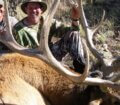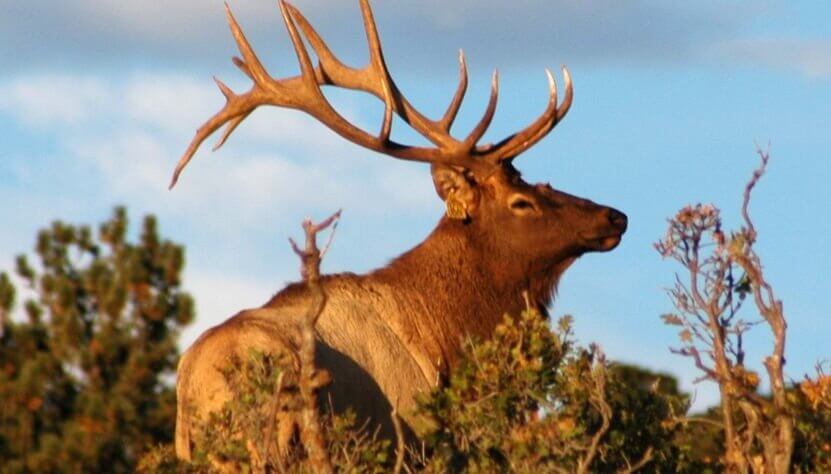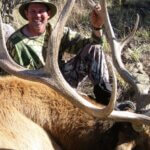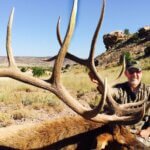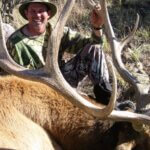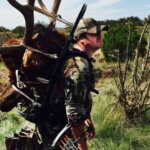Editor’s Note: Elk outfitter Tom McReynolds (tom@bmo.hunts.com) (Phone: 602-705-4297) says, “I played baseball in college, and I needed a way to make some extra money. I had a friend older than me who was guiding for elk and mule deer. He asked me if I wanted to start guiding hunters when I wasn’t playing baseball for a part-time job while in college. During the fall, we weren’t practicing or playing baseball. Then, when I graduated from college, I started Black Mountain Outfitters. During this time, I guided in an area where I knew some of the owners of the land and started negotiating with them to lease the private property they owned for elk and mule deer.
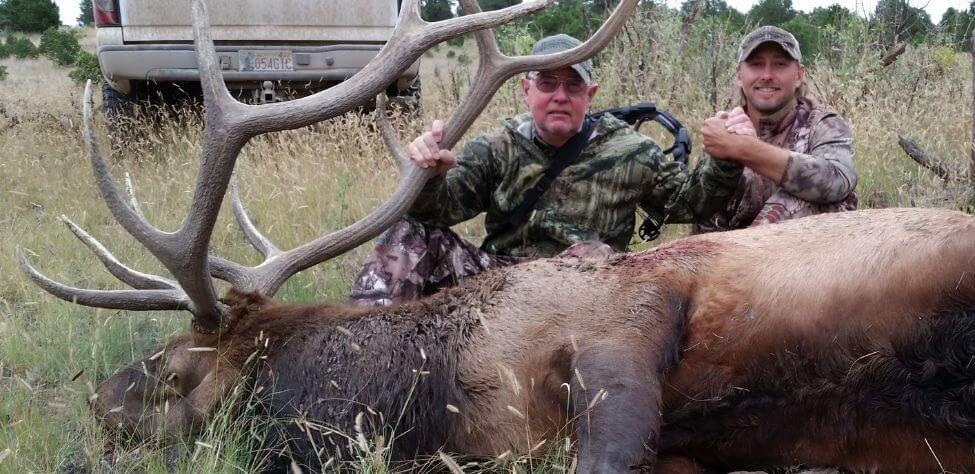
“My primary area at that time was west/central New Mexico because it was only 4.5 hours away from where I lived. There weren’t many outfitters in that area, but currently, we have over 1 million acres of private land that we can hunt, as well as quite a bit of public land. I have been guiding for over 20 years now, and Black Mountain Outfitters operates four different camps – our main camp is located in western New Mexico, South Dakota, Mexico, and Arizona. Although we primarily guide for elk, we also have many mule deer, longhorn, and whitetails in South Dakota and Coues deer in Mexico.”
John E. Phillips: What do you do when a bull walks past your hunter, but your hunter doesn’t have an opening to take the shot? How do you get the bull to come back in front of your hunter, or how do you move him to be in front of the bull to take the shot at a different location? Do you change calls?
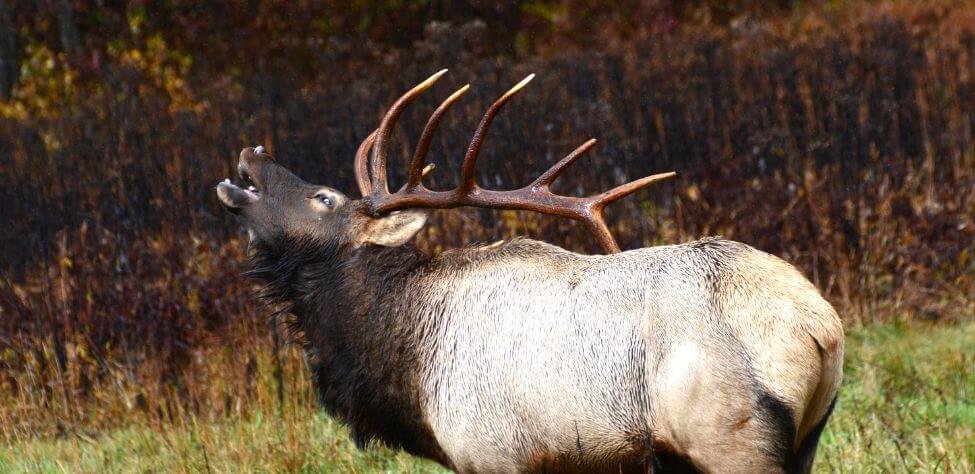
Tom McReynolds: My job as the guide is to use my knowledge and calling ability to drag the bull in front of and broadside to the hunter. I’ll be about 100-150 yards behind the hunter. If the bull’s not coming in the way he should, I’ll try to move and call to cause the bull to come toward me and hopefully walk in front of the hunter on his way to me.
Remember that the bull’s attention is on the caller. So, I don’t want to be directly behind the hunter. I want to take a position on either the left or the right side of the hunter. Then, whichever side the bull’s coming from, the hunter is in his line of travel. However, if the bull is moving in from upwind and trying to get behind us to determine if we’re elk or hunters, I’ll move to a zone where the hunter can see him first. I’ll often be off to the hunter’s side rather than bringing the bull directly to the hunter. I don’t want the hunter to move from where I’ve set him up to take the bull. The bull and I should be the only things in that area that are moving.
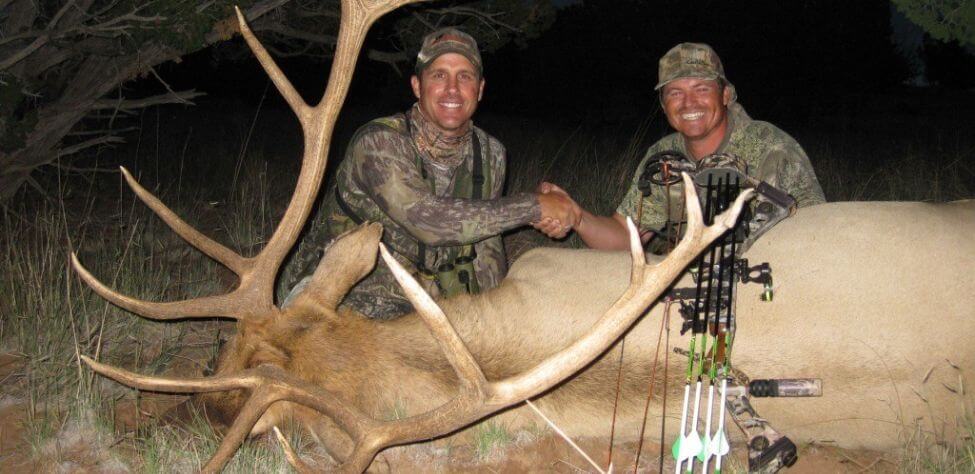
Some guides get too close to their hunters to be effective. I try to get at least 100 yards away from the hunter so I have more room to move the bull past the hunter by calling. With a smart bull, if you’re too close to the hunter, the bull oftentimes will hang up in front of the hunter, expecting the cow to come to him. A large part of a successful elk hunt is making sure you’ve got a shooting lane identified through which your hunter can shoot. Once I make sure the hunter has a lane to shoot through, whether, with a bow or a gun, I can move further away from the hunter without being seen and sound like a cow elk walking away from the bull to cause the bull to turn broadside to my hunter.
Expert Guidebooks on Elk Hunting: Best Sellers

Secrets for Hunting Elk
The quickest, easiest (if there is an easy way), and safest way to find and take that bull elk of a lifetime will be to hunt with a guide.
Chad Schearer, a longtime Montana guide and TV personality, told me, “My hunter is my gun. If I get to the elk, and my hunter isn’t with me, then we don’t take the elk. My job is not only to find the elk but also to help the hunter get to the elk and make the experience as enjoyable as I can for him.” That’s the kind of fella with whom I want to go elk hunting.
An elk hunt can be tough, but it doesn’t have to be so tough that you don’t enjoy it. That’s why this elk hunting book starts with the confessions of an elk guide and with Chad Schearer’s philosophy of what the guide and the hunter’s relationship should be.
A good portion of your success will depend on your physical condition, and Matt Morrett of Harrisburg, Pennsylvania explains how an eastern hunter can get ready physically during June and July to hunt western elk, the animals he describes as, “Like deer or turkeys on steroids.”
Wayne Carlton, well-known elk hunter and TV and video personality from Montrose, Colorado, tells us what types of elk calls to use and what to say to the elk. Mike Miller of Colorado, another elk guide and Mossy Oak video personality, has tactics for the best equipment for bowhunting and gun hunting elk.
You’ll learn helpful strategies and hunting tips in this book, as well as some straightforward hunting methods that will help to make your elk hunt more successful.
“Thanks to the advice in your elk hunting books, I was able to call up a nice 6-point (6X6) bull elk! He was bugling like crazy. I called him in from about a ¼ mile away. Called him into bow range (about 40 yards away). It was a thrill!” ~Rob Brannon
VERSIONS: AUDIBLE & KINDLE

Elk: Keys to 25 Hunters’ Success
Often just one tip or tactic makes the difference in whether you take an elk home to dinner or have to hike back to the truck by yourself. In John E. Phillips’ latest elk book, Elk: Keys to 25 Hunters’ Success, you’ll learn from successful elk hunters the strategies they use to find and take elk.
Many know that the technique that seems to work most often is to hunt where other elk hunters don’t and understand where the elk are before you go on a hunt by studying data from each state, visiting HuntData (see chapter 1), examining maps, and reading postings on elk forums.
This book also tells you how to get ready physically for an elk hunt, including participating in Train to Hunt Competitions, what gear you need to take, how to enjoy a successful do-it-yourself elk hunt, or how to pick the best elk guide for you. You’ll also hear about the X System and the Broken Y System of hunting elk.
Although no one person has all the answers on how to help you find and take your elk, I’m convinced that this book’s outdoors men and women will teach you how to have satisfying elk hunts.
As my friend Karl Badger once told me, “Elk hunting doesn’t get any better than when I ride horses into the high backcountry, see two grizzly bears, hear a pack of wolves howl close to camp all night long, eat plenty of delicious food prepared on a fire and enjoy the company of good friends.”
VERSIONS: AUDIBLE, KINDLE & PRINT

How to Find Your Elk and Get Him in Close will teach you the tactics of 10 nationally known elk hunters, to help put that giant bull that’s been screaming at you from afar, in your lap. You’ll learn what some of the best guides, outfitters, and successful elk hunters do to find elk and get them in really close.
Also in this audiobook, you’ll notice that the majority of the experts call elk to within bow range. We selected numerous bowhunters and bowhunting guides, since the bowhunter has to get much closer to a bull than the gun hunter does – often less than 20 or 30 yards – practically in your lap.
On one elk hunt, I’d heard this bull bugle all morning. My guide had called him within 30 yards, and he was standing just inside black timber. I saw the smoke from his nose wafting out into the icy air less than 30-yards away. All the bull had to do was step out, and I could take the shot with my bow. But then, through no fault of my guide or me, the bull vanished.
The only conclusion I could come up with to understand why the bull I wanted to take with my bow hadn’t stepped out and given me a shot, was because he got raptured. He evidently had left the earth with no trace of himself.
This hunt was when I started wanting to learn more about hunting elk up close. In this book, I’ve tried to find some of the most knowledgeable, experienced, and practical elk hunters. I’ve always found that the best way to learn any outdoor skill, is to either hunt or fish with the best sportsmen in that field.
Often, in elk hunting, that means elk guides, who generally hunt every day of the season and receive a salary for every hunter they guide. So, I’ve put together a group of some of the best elk hunters I know to help us all learn how to find bull elk and get them in close.
VERSIONS: AUDIBLE, KINDLE & PRINT
Tomorrow: Solutions to Elk Hunting Problems


